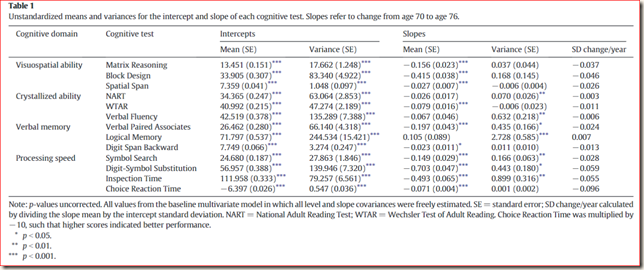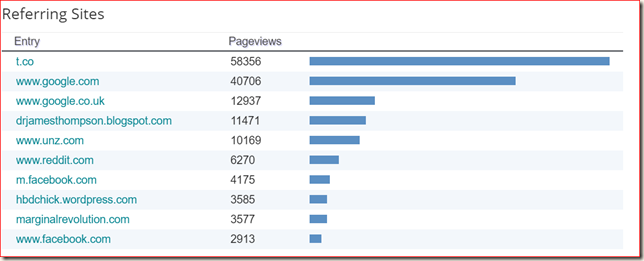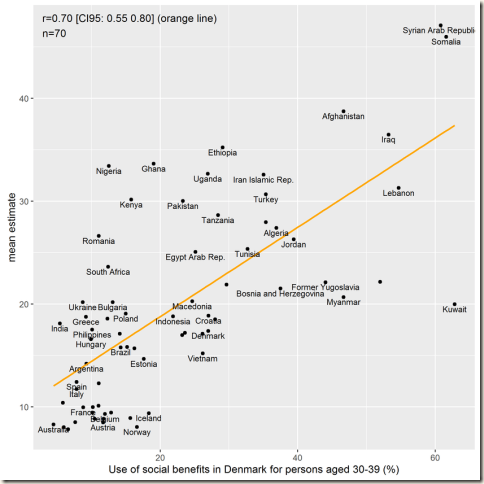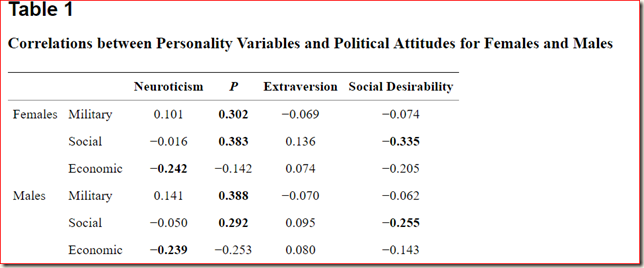
As you know, I don’t do policy, but I am aware that there is an election happening in the US, and it is a particular feature of this election that each side is accusing the other side of being very stupid. You may feel that one side does it more than another, but that is one of the features of taking sides. No surprise about this polarization: the preferences of others can be bewildering, and stupidity is a plausible cause of the odd choices other people make.
As a general rule, democratic choices will tend to reflect the average mental ability of electors, who have to work out which party is best for them and for their country (which equates to what is best for them in the long run). This requires them to understand what is being offered, determine how sensible those offers are, and how likely they are to be delivered. This is usually a difficult process, ideally requiring a detailed examination of policy positions, a careful study of what might happen as a consequence of the projected changes, and an evaluation of each party’s track record in implementing new laws. These are complex matters, requiring high ability and persistence. Thinking that hard about how to vote is probably a minority interest. Talking of minorities, in a representative democracy one hopes that the elected might be brighter than the average elector. Hopes. The intelligence level of the elected leadership is an important matter, as well as their probity.
https://drjamesthompson.blogspot.co.uk/2015/09/the-intelligence-of-governments.html
The method for determining the intellectual ability of electors of different parties should be simple: find a dataset which contains mental ability measures and political allegiance classifications, and see what the scores look like for each political party.
However, not all researchers are in favour of simple approaches. They seem to find them crude, misleading, and even vulgar. So, in addition to tussles between Democrats and Republicans we have a battle between the research parties of Descriptive Statistics and Corrected Confections. I make no pretence of neutrality on this issue: I think researchers should start with Descriptive Statistics, and then give justifications at each stage as they apply each putative “correction”. This allows us to make our own choices about each correction: is it justified, and worth applying, or are important issues being smoothed away?
Noah Carl (2014) found that Republicans were brighter than Democrats by 2-3 IQ points, and that a Republican advantage held true even when allowance was made for socio-economic status. The IQ difference was largest for committed supporters of each party. Sample sizes were large in his study, and the mean differences sufficient to have real life consequences.

Note that among committed supporters Republicans are 5 IQ points ahead on Vocabulary and 3 IQ points ahead on probability, verbal reasoning and comprehension. Brighter, in fact. Assume for the purposes of argument that Democrats are IQ 99 and Republicans IQ 102 thus reflecting the observed 3 point difference which I will take as a summary of the results. Then at IQ 130 (+2 sigma, or elite university level equivalent) we will find 1.9% of Democrats and 3.1% of Republicans. Highest paying jobs will mostly be obtained by Republicans. At +1 sigma, corresponding to white collar jobs, we will find 14.3% of Democrats and 19.3% of Republicans. Finally, if we consider an IQ of 93 to be required for most reasonable jobs, then 34.5% of Democrats will be rejected, and only 27.4% of Republicans. Differences of a mere 3 IQ points on average become more evident at the extremes, and can inflame political discussions. Democrats will be slightly more likely to feel aggrieved about job opportunities and status than Republicans.
Here is the link to the Noah Carl (2014b) paper:
https://drive.google.com/file/d/0B3c4TxciNeJZdWRRTVMzN0lWa0U/view?usp=sharing
What does Yoav Ganzach (2016) find?
Cognitive ability and party identity: No important differences between Democrats and Republicans. Intelligence 58 (2016) 18-21
Here is the link to the Yoav Ganzach paper:
https://drive.google.com/file/d/0B3c4TxciNeJZV0l5dVRrS0czUEU/view?usp=sharing
Unfortunately, I cannot give a simple account of what he finds, because I cannot find a table in Ganzach’s paper which plainly compares the raw scores for Republicans and Democrats as done by Noah Carl above. Table 1 could have given the raw results, but instead gives correlations, and this obscures a plain understanding of the IQ differences between the parties.

The intellectual measures are positively correlated with White and negatively correlated with Black. Instead of means there are many tables of regressions once the “controls” have been activated. Here is Ganzach’s argument:
The zero order correlations between our measures of cognitive abilities and our measures of republican identification are significantly positive for three of our four measures of cognitive ability (p< 0.0001), indicating that without controlling for SES and race, the cognitive abilities scores are higher for those who identify as republicans than for those who identify as democrats. However, when SES and race are controlled these differences disappear and even reverse.
Ganzach argues that Carl should have done an additional correction for race, and that when that alteration is made then the Republican advantage is not present. Of course, another interpretation, as Ganzach is well aware and discusses at the end of his paper, is that he reveals the Republican advantage only to make it disappear by assuming that Black Democrats can be controlled away. If that is done, one can show that White Democrats are as bright as White Republicans. This is in line with previous findings: you can be on the Left because you are clever, or because you seek a compensation payment.
https://drjamesthompson.blogspot.co.uk/2014/10/are-lefties-clever-or-just-grasping.html
I find it tiresome when researchers repeat the Sociologists Fallacy that it is right to “correct” for social class, as if people were allocated to occupations randomly in an experimental model. Not so. Brighter and more diligent persons tend to get better occupations, and to try to wash that away with a regression loading (a penalty for education and income) is to ignore reality. (In this case the SES measures used were years of education and income).
Similarly with race. If more Black Americans vote Democrat, thus lowering the average intelligence levels for that party, that is a fact of political life. Sure, it would be interesting to look at the intelligence of white Republicans and white Democrats, but it does not deny the facts on the ground when the question is whether Republicans are brighter than Democrats as a whole.
The author concludes: The two studies presented in this paper suggest that once SES and race are controlled for, there is a very little difference between Democrats and Republicans in cognitive ability.
He adds:
Could it be argued that controlling for race and SES obscures the real relationship between cognitive ability and party identity, and that the effects of race and SES on party identity are really effects of cognitive ability? This argument is not in line with the view that to demonstrate convincingly that between-groups differences in an ability test are associated with between-groups differences in GMA, it is also necessary to demonstrate that between-individuals differences within each of the groups are associated with between-individuals differences in GMA (Jensen, 1998; Jensen & Figueroa, 1975). This is not the case for party identity since although between-groups differences in party identity are associated with between-groups differences in cognitive ability, within each of the groups party identity is not associated with cognitive ability.
Comment: I find this difficult to follow. Party identity is not an achievement score, and does not have as much range as mental ability, so correlations are restricted in range. More to the point, we do not have to prove anything. We just observe that one group is brighter than another because of the intellectual level of the people they attract.
Within the context of the current study, cognitive ability may have three important associations with party identity. It is associated with party identity because (1) people who come from higher SES strata tend to score higher on cognitive ability tests as well as to identify more with the Republican party; (2) Blacks tend to score lower on cognitive ability tests as well as to identify more with the Democratic party; and (3) the level of cognitive processing associated with identifying as a Democrat is different from the level of cognitive processing associated with identifying as a Republican. Thus, although Republicans may very well score higher in cognitive ability tests, this effect is, in our view, of little interest since it could be explained by SES and by ethnic differences in test scores. The question of real interest is whether there are differences in the level of cognitive processing necessary for adopting a Democrat vs. Republican identity, or, roughly speaking, whether is it more intelligent to be a Republican than to be a Democrat.
Comment: I do not know if there are different mental processes involved in joining different parties. The parsimonious model would be that people join the parties which reflect their values and their needs. Black Americans probably feel that the Democratic party is closer to their causes and offers them more, and that is enough for any voter. The crunch comes in the penultimate sentence above: although Republicans may very well score higher in cognitive ability tests, this effect is, in our view, of little interest since it could be explained by SES and by ethnic differences in test scores. I disagree that it can be “explained” because there is an equally strong explanation that brighter people become Republicans because they understand that Republican economic and social policies are better in the long run. The American Dream and so on. As part of this intelligence-based explanation, any less bright group will be less likely to understand those benefits. (This is easily testable, by looking at the voting preferences of all minorities ranked by intellect. How do the Chinese, Japanese, Vietnamese people in the US vote: Democrat or Republican? Which way do Mexicans incline? Democrat or Republican?)
As our results indicate, the answer to this question is negative.
Comment: In fact positive, before corrections render the difference “unimportant”.
Finally, we note that the issue of applying appropriate controls is a fundamental issue in intelligence research. Many studies in the intelligence literature adopt a conservative approach, and assess the effect of intelligence only after controlling for basic background variables such as race and SES. Other studies, including recent studies about the relationships between intelligence and political attitudes (Carl, 2015; Solon, 2014), assess the effect on intelligence without partialing out the effects of background variables. It is still an open question whether the results of these recent studies hold when control for such variables is exerted.
Comment: how can a contentious “correction” take precedence over the simple results? Surely one should have the simple description first, and the controlled version second? We should start by being impartial, and then by exploratory degrees consider the arguments for adjusting the findings, justifying each use of partialing out of presumed confounders.
It is a pity that one can read the entire paper without finding means and standard deviations (remember those?) for the ability measures by race and by social class. That would allow readers, by comparing the results with those derived from other samples, to judge whether they are in the right ball park with other research. Why obscure the most important data when you are writing a paper about cognitive ability? The paper says: “no important differences”. Well, where are the differences in plain text so that we can judge for ourselves?
Now to the upcoming US election. I am aware that intelligence is only one ingredient in voting behaviour, and that deep emotions are stirred by politics, leading to tribal loyalty and blind allegiance to all manner of absurdities. However, to my mind the question, shorn of adjustments, is answered thus: Republicans are brighter than Democrats. So, it follows that we intelligence researchers must predict that Republicans will make the best choice, the one most soundly based on an appreciation of reality, and will make the most accurate prediction as to what would be best for America. The implication is that Republicans will make better choices. That is the theory, and I stand by it, in the sense of backing it only until better data becomes available and it is proven wrong.
However, if Republicans are truly brighter than average there will probably be fewer of them than Democrats, just as a feature of the bell curve, so they will lose the election, since all votes count equally and are not “corrected” for intelligence.
Do let me know how the whole US election thing turns out. On reflection, let me know 4 years from now. No sense in rushing to judgment on these important matters.
To quote my Twitter self: Hard to say which is worse: the party you vote for fails to get in, or the party you vote for gets in and fails you.


























